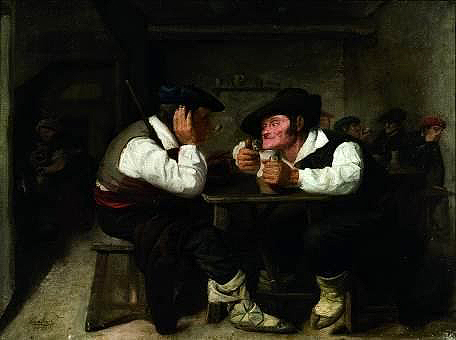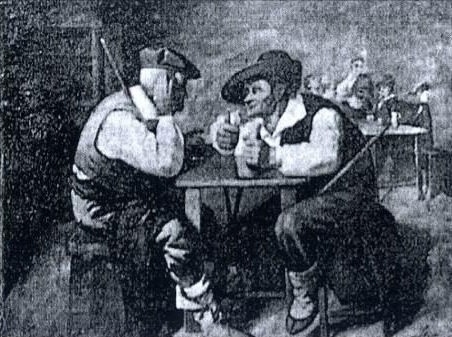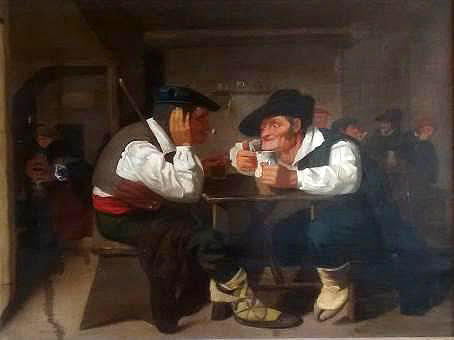The piece of the month of March 2020
A POSSIBLE PAINTING BY ANTONIO MARÍA LECUONA RECOVERED: "COLLOQUIUM BETWEEN TWO DRINKERS" (1871)
Iñaki Urricelqui Pacho
PhD in Art History
Antonio María Lecuona is considered one of the pioneers of Basque genre painting and teacher of a whole generation of artists. Born in Tolosa on January 17, 1831, he studied programs of study of Philosophy in the seminar Conciliar de San Miguel of Pamplona between 1848 and 1851, and attended the public Academy of drawing and painting between 1848 and 1850. Settled in Bilbao, he continued his training with Cosme Duñabeitia, moving in 1853 to Madrid, where he studied at the San Fernando School of Fine Arts. In 1857, he obtained the place of draftsman of the Museum of Natural Sciences of Madrid, position from which he resigned in 1866, settling with his family in Azpeitia. In 1869, he moved to Bilbao, where he opened a studio and ran a private academy. During this period he took part in the National Fine Arts Exhibitions of 1856, 1860, 1864 and 1871, obtaining an honorary accredited specialization for "Costumbres Vascongadas" (Bilbao Fine Arts Museum) in 1860. Due to his sympathies with Carlism, he left Bilbao in 1873 before the imminent siege of the troops loyal to the pretender Carlos VII. After a stay in Bergara, where he was appointed "chamber painter" of the aforementioned pretender, he returned to Bilbao to continue the classes in his academy, where artists such as Anselmo Guinea, Adolfo Guiard, Paco Durrio, Gustavo de Maeztu, and Miguel de Unamuno were trained. In the following years he competed in some contests, such as the exhibition Provincial de Vizcaya (1882), the Fiestas Euskaras de Durango (1886), the Juegos Florales de San Sebastián (1886), although without much success in the face of the incipient modernization of Basque painting, which caused him to withdraw from public life. From 1901, Lecuona retired to Ondarroa with his family, where he continued to work until his death on September 26, 19071.
Valued in its context, Lecuona's work is one of the most decisive contributions to the foundation of Basque costumbrismo, where the influences of Golden Age painting coexist and, above all, the debt of Flemish painting, in the manner of David Teniers the Younger, which he transposed to the Basque universe, defining some themes and types that would later be recurrent in Basque painting in the late 19th and early 20th centuries2. Outstanding works of his production are "Basque Customs" (1860, Bilbao Fine Arts Museum), "Biscayan Village Girl in the Market" (1871, Bilbao Fine Arts Museum), "The Blessing of the Table in a Biscayan Farmhouse" (1971, Alava Fine Arts Museum, in Vitoria-Gasteiz), "colloquium between two drinkers" (1873, file Municipal de Pamplona), "Don Carlos de Borbón receiving in Durango the representation of the Merindades de Vizcaya on May 3, 1874" (1875, Provincial Council of Bizkaia, deposited in the Museum of Art and History of Durango), "San Ignacio wounded in the heroic defense of the castle of Pamplona" (1884, Community of the Sanctuary of Loyola, Azpeitia, Gipuzkoa), "Entrática en Las Huelgas" (1898, Museum of Fine Arts of Bilbao). It is also known that in 1875 he painted the "Oath of Don Carlos de Borbón under the tree of Guernica as Lord of Vizcaya on July 3, 1875", which was confiscated and destroyed by the Alfonsine troops after his entrance in Guernica.
One of the most dramatic episodes of his biography took place on the afternoon of January 13, 1877, when a fire broke out in his studio which, although it was controlled by the firemen, caused the loss of many of his paintings, "originals by Mr. Lecuona, some of them awarded at the exhibition of Fine Arts of Madrid", the chronicles expressly mentioning titles such as "La limosna", "La bendición de la mesa", "La niña de la calceta", "La romería", as well as other paintings, among them fourteen sketches copies by Lucas Jordan that Lecuona had taken during the restoration he carried out on as many originals kept in the sacristy of the Basílica de Begoña, and "other [paintings] of customs", also destroyed3.
This episode and the information provided by the sources of the time have led to consider that most of the artist's production to date was destroyed, so that the works that have come down to us must be either restored works or versions that the artist himself would have made before or after the fire. Thus, for example, several versions of the canvas "Una limosna" are known: one in the collection of the Bilbao Fine Arts Museum and the other two in private collections, and which are apparently versions of the work of the same name presented at the National Fine Arts Museum of 1864 and which was among those burned in the fire4.
Something similar must have happened with the painting graduate "colloquium between two drinkers", one of the most indebted to the influence of Teniers, which appeared together with "The blessing of the table in a farmhouse in Vizcaya" in the exhibition National Fine Arts of 18715. Lecuona himself painted a version of this canvas in 1873, a work that is preserved in the file Municipal de Pamplona (Image 1)6, and it is known that it was copied in his studio-academy by some students such as Benito Barrueta (private collection) or Miguel de Unamuno (Casa Museo Unamuno, University of Salamanca), whose contact with Lecuona took place from 18767 onwards. In addition, Lecuona's original painting has been identified as one of those that appears on the back wall of "Portrait of the Lecuona-Echeverría family" (private collection), painted by the artist between 1874 and 1876, below an Immaculate Conception and "Basque Customs "8.

Antonio María Lecuona, "Carlistas. colloquium entre dos bebedores", 1873.
file Municipal de Pamplona.
"colloquium between two drinkers" represents a scene set inside a tavern and clearly influenced by the work of Teniers. In the foreground stand out two men sitting around a table and characterized by their costumes, of costumbrista aspect, where the white of the shirt and the cream of the albarcas contrast with the browns and blues of the vest and pants, being the grade of color the red sash of the fellow guest who sits on the left and sharpens his ear with his right hand. Of special interest is the subject Arratiano, on the right, dressed with a large brimmed hat folded back and his wide shirt collar, and that would mark an ethnotype treated by different later Basque artists, some of them trained together with Lecuona9. After the main scene, two anecdotes unfold. On the right, four characters with berets, two of them red -perhaps in allusion to their status as Carlists- converse in a corner; on the left, a frowning barmaid fills one of the wine jars.
It is not really known if "colloquium between two drinkers" was one of the paintings destroyed in the fire, since the sources of the time do not mention it expressly, as is the case with other titles, as we have seen. It has been rather the bibliography about the artist that has assumed and maintained this idea. Nevertheless, in 1901, Pilar de Zubiaurre, in a article that she dedicates to a visit made to the artist's house in Ondarroa, informs that he conserved then "a collection of small paintings that in the style of those of Teniers reproduced Basque scenes of great popular flavor "10. If the accredited specialization in 1877 to "other [paintings] of customs" destroyed leads us to think that "colloquium between two drinkers" was among them, this accredited specialization of 1901 leads us to think, by the same criteria, that it could be referring, among others, to the painting we are interested in. Besides, in 1904 the magazine La Baskonia, of Buenos Aires, reproduced the painting, although titled "Bautizando "11 (Image 2). If we compare the version of the file Municipal de Pamplona and the reproduction in the Buenos Aires magazine, we notice subtle differences -for example, the Arratiano in the foreground has a rod in the magazine, which the painting lacks; the arrangement of the types in the background also varies-, which leads us to affirm that these are two different works. This reproduction of La Baskonia could have been made from a drawing taken from life, with variations with respect to the original, or from some preparatory material of the original painting12.

Antonio María Lecuona, "Bautizando". Whereabouts unknown,
reproduced in La Baskonia ( 1904).
A painting identical to the one in the possession of the file Municipal de Pamplona has recently been located in a private collection in Pamplona (Image 3)13. Both represent the same scene, although the first one is not signed, as neither is "La bendición de la mesa en un caserío de Vizcaya", from the Museo de Bellas Artes de Álava14, a work by Lecuona that was paired with the first one in the exhibition Nacional de Bellas Artes of 1871. The Regulations do not specify anything about whether the paintings presented had to be signed or not15. What does seem interesting to note is that the measurements of this painting from a private collection, 38x46 cm, fully coincide with those provided by the Catalog of the exhibition Nacional de Bellas Artes of 1871 in relation to "colloquium entre dos bebedores", presented by Lecuona in that edition16. In addition, a comparative analysis of this painting from a private collection and the version of the file Municipal de Pamplona, signed by Lecuona, reveal compositional, chromatic and stylistic similarities that lead us to affirm that both were made by the same hand, although some slight differences should also be noted, such as the head of the Arratian, slightly more tilted in the 1873 version.

Antonio María Lecuona, "colloquium entre dos bebedores", 1871.
Private collection (Pamplona).
Given these considerations, it seems plausible to hypothesize that the painting located in a private collection may be the original version presented at the National exhibition of 1871. This finding, in any case, is an interesting contribution to the known Catalog of works by Antonio María Lecuona, as well as to the historiography of contemporary Basque painting, as "colloquium between two drinkers" is a work that was important in the training of the students that the master had in his studio in Bilbao and is one of the pioneers of pictorial costumbrismo in the Basque Country. In addition, as it is located in a private collection in Pamplona, it is part of the Cultural Heritage of Navarra.
NOTES
1Themain work on Lecuona corresponds to Lertxundi 2015. For more punctual contributions and assessments about the artist, Llano Gorostiza 1966: 30-33, 40 and 245; Álvarez Empananza 1973: 28, 40, 42 and 44; Guasch 1985: 32; Barañano, González de Durana, Juaristi, 1987: 215; Madariaga, 1988: 47; Marrodán 1989: 242-243; Fernández López 1993: p. 117; Begoña and Azcárraga 2002: 135-136; Fornells, 2013.
2Thiscontribution to painting was already pointed out by Unamuno in Recuerdos de niñez y mocedad when he stated that "his influence on the artists from Bilbao and in general from the Basque Country who have succeeded him is undeniable", Unamuno 1988: 188. Lecuona, who became close friends with Antonio de Trueba, also contributed to the diffusion of the Basque archetype in the context of fuerist literature, as Juaristi 1998: 168 points out.
3ElNoticiero Bilbaíno, January 14, 1877, p. 3; January 18, 1877, pp. 2 and 3. Lertxundi has analyzed and clarified the episode, until now dispersed and ambiguous, through the documentation of the time. He even refers to the possibility that the fire had been set as a reprisal for his Carlist position, an idea maintained in the family's report . Lertxundi 2015: 33-35.
4Lertxundi2015: 89, 112 and 113.
5Catalog of the exhibition Nacional de Bellas Artes de 1871 (1871: 66)
6Caspistegui2010: 73, who relates it to the theme of the Carlist conspiracy. This painting was donated by a private individual to the Pamplona City Council in 1961. I am grateful to Ana Hueso (file Municipal de Pamplona) for providing me with this information.
7ParedesArnáiz 2013. For copies, Nieto González and Azofra Agustín 2002: 139-141; and Lertxundi 2015: 77.
8Lertxundi2015: pp. 67-68.
9Forexample, artists such as Paco Durrio or Alberto Arrue dedicated attention in their work to the Arratian, as well as Miguel de Unamuno himself, in a drawing of the Casa Unamuno, of the University of Salamanca, or a contemporary such as José Bringas, in a drawing preserved in the Museo de Bellas Artes of Bilbao.
10Zubiaurre1946: 4.
11Lertxundi2015: 93. I thank Eneko Tuduri for access to a copy of the copy of La Baskonia. The "baptism" refers to the fact that, according to the magazine, the barmaid depicted in the painting is watering down the wine, which is commented on by the two foreground figures.
12Forexample, a watercolor of the painting "La bendición de la mesa en un caserío de Vizcaya" is known, from a private collection, Lertxundi 2015: 93.
13Thispainting presents a regular state of conservation, with some stains, detachments and breaks, although it allows a correct stylistic and thematic evaluation with respect to Lecuona's work.
14https://apps.euskadi.eus/emsime/catalogo/autoria-lecuona-y-echaniz-antonio-maria-/titulo-la-bendicion-de-la-mesa-en-un-caserio-de-vizcaya/objeto-pintura/ciuVerFicha/museo-1/ninv-2876 (accessed 28-1-2020).
15Reglamento de Exposiciones Nacionales de Bellas Artes C by S. M. on April 2, 1871. (1871: 7-9).
16Catalog of the National Fine Arts exhibition of 1871 (1871: 66).
SOURCES AND BIBLIOGRAPHY
Catalog of the exhibition Nacional de Bellas Artes de 1871, Madrid, Imprenta del high school Nacional de Sordomudos y Ciegos, 1871.
El Noticiero Bilbaíno, January 14, 1877, p. 3.
El Noticiero Bilbaíno, January 18, 1877, pp. 2 and 3.
La Baskonia: revista ilustrada euskaro-americana: historia, literatura y artes, Buenos Aires, January 10, 1904, p. 163, no. 370.
Reglamento de Exposiciones Nacionales de Bellas Artes C por S. M. en 2 de abril de 1871, Madrid, Imprenta del high school Nacional de Sordo-Mudos y de Ciegos, 1871, pp. 7-9.
ZUBIAURRE, P. de., "La casa del pintor", in Euzko-Deya México D.F., n.º 71, April 1946, p. 4.
ÁLVAREZ EMPANANZA, J. M.ª, Origen y evolución de la pintura vasca, San Sebastián, Caja de Ahorros Provincial de Guipúzcoa, 1973, pp. 28, 40, 42 and 44.
BARAÑANO, K. M., GONZÁLEZ DE DURANA, J. and JUARISTI, J., Arte en el País Vasco, Madrid, Chair, 1987.
BEGOÑA Y AZCÁRRAGA, A., "Particularismos y reservas. Basque artists in the romantic movement", Ondare, n.º 21, 2002, pp. 113-143.
CASPISTEGUI, F. J., Catalog of the temporary exhibition Una historia por descubrir. Materiales para el estudio del carlismo, Pamplona, Gobierno de Navarra, 2010, p. 73.
Catalog of the exhibition Nacional de Bellas Artes de 1871, Madrid, Imprenta del high school Nacional de Sordomudos y Ciegos, 1871, p. 66.
FERNÁNDEZ LÓPEZ, A., Basque painters. In the collections of the Savings Banks, I, Bilbao, BBK, Kutxa and Caja Vital, 1993, p. 117.
FORNELLS ANGELATS, M. (), Catalog of the exhibition Pintores románticos guipuzcoanos, San Sebastián, Fundación Kutxa, 2013.
GUASCH, A. M., Arte e ideología en el País Vasco 1940-1980, Madrid, Akal, 1985.
JUARISTI, J., El linaje de Aitor. La invención de la tradición vasca, Madrid, Taurus, 1998.
LERTXUNDI, M., The painter Antonio María de Lecuona (1831-1907). Pioneer of Basque costumbrismo, Bilbao, Bilbao Fine Arts Museum, 2015.
LLANO GOROSTIZA, M., Basque Painting, Bilbao, Artes Gráficas Grijelmo, 1966, pp. 30-33, 40 and 245.
MADARIAGA, L., "Lecuona Echániz, Antonio María", in B. Estornés Lasa (dir.), Enciclopedia General Ilustrada del País Vasco. Body A. Basque Encyclopedic Dictionary, vol. XXIV, San Sebastian, Auñamendi, 1988, p. 47.
MARRODÁN, M. Á., Dictionary of Basque Painters, vol. II, Madrid, Beramar, 1989, pp. 242-243.
NIETO GONZÁLEZ, J. R. and AZOFRA AGUSTÍN, E., Inventario artístico de bienes muebles de la Universidad de Salamanca, Salamanca, Universidad de Salamanca, 2002.
PAREDES ARNÁIZ, A. M., Unamuno y las artes 1888-1936, thesis doctoral, department de language y Literatura Hispánicas, Universitat de Barcelona, 2013. http://hdl.handle.net/10803/110575 (Accessed February 19, 2019).
UNAMUNO, M., Recuerdos de niñez y mocedad, Madrid, Alianza, 1998.
